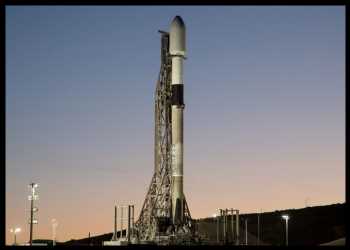The Space Development Agency (SDA) has launched the first batch of satellites that will be part of a network of hundreds of small satellites to counter emerging threats posed by advanced missiles such as hypersonic missiles to the United States.
A SpaceX Falcon rocket from Vandenberg Space Force Base, California, launched the first 10 of the planned 28 satellites Sunday.
The first tranche of SDA’s satellite fleet, called the Proliferated Space Warfare Architecture, will demonstrate the low-latency communication links to support the war fighter with a resilient network of integrated capabilities, including tracking of missile threats, from low-Earth orbit.
The first batch will include 20 optically-connected data transport satellites and eight optically-connected missile warning/missile tracking satellites equipped with wide-field-of-view sensors.
The launch of the second set of satellites is scheduled for June.
“This is a major accomplishment for SDA and for the whole Department of Defense. It shows that our key pillars, proliferation and spiral development, can deliver for national security space,” said Derek Tournear, director of SDA. “Through this launch, we’ve demonstrated that SDA can keep a schedule to deliver enhanced capabilities every two years. This revolutionary approach is enabled by growth in the commercial marketplace, allowing the PWSA to move forward to deliver warfighting capabilities in each future tranche,” he added.
The launch was originally scheduled for March 30, but was delayed to investigate technical issues with the launch vehicle.
York Space Systems provided eight Transport satellites and SpaceX provided two Tracking satellites. York Space Systems and Lockheed Martin will produce 10 Transport satellites each, for a total of 20 Transport satellites. SpaceX and L3Harris will provide four Tracking satellites each. Ground support is provided by the U.S. Naval Research Laboratory.
Transport satellites, each costing approximately $15 million, were handed over to SDA approximately 30 months after authority-to-proceed on each contract.
The T0 demonstration constellation will fly in two orbital planes at an altitude of approximately 1,000 kilometers. Once on orbit, the satellites must undergo a period of test and checkout of the bus and mission payloads before demonstrations can begin.
The constellation will serve as the war fighter immersion tranche and support military exercises, including advanced missile tracking tests, in the summer of 2023 and beyond, the Pentagon said.
Tranche 0 will demonstrate the feasibility of Low latency data connectivity, Beyond line of sight targeting, Missile warning/missile tracking, On-orbit fusion and multi-phenomenology ground-based sensor fusion.
SDA said it plans to field the first operational generation of the PWSA, Tranche 1, beginning in late 2024. Tranche 1 will include 126 Transport Layer satellites, 35 Tracking satellites, and 12 tactical demonstration satellites, or T1DES. Tranche 1 will be operated by SDA’s groundbreaking space operations centers based heavily on commercial space operations models.
The Space Development Agency is a United States Space Force direct-reporting unit tasked with deploying disruptive space technology. Its primary focus is space-based missile defense using large global satellite constellations made up of industry-procured low-cost satellites.
SDA programs provide an integral part of the national security hybrid space architecture in the areas of communications, data transport and missile warning.
Source: Read Full Article

